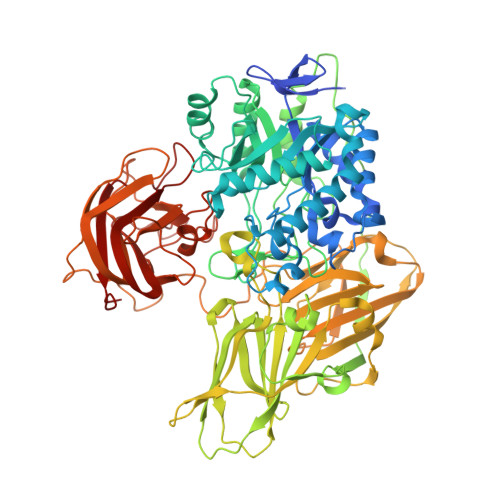A surface endogalactanase in Bacteroides thetaiotaomicron confers keystone status for arabinogalactan degradation.
Cartmell, A., Munoz-Munoz, J., Briggs, J.A., Ndeh, D.A., Lowe, E.C., Basle, A., Terrapon, N., Stott, K., Heunis, T., Gray, J., Yu, L., Dupree, P., Fernandes, P.Z., Shah, S., Williams, S.J., Labourel, A., Trost, M., Henrissat, B., Gilbert, H.J.(2018) Nat Microbiol 3: 1314-1326
- PubMed: 30349080
- DOI: https://doi.org/10.1038/s41564-018-0258-8
- Primary Citation of Related Structures:
6EON, 6EUF, 6EUG, 6EUH, 6EUI, 6EUJ - PubMed Abstract:
Glycans are major nutrients for the human gut microbiota (HGM). Arabinogalactan proteins (AGPs) comprise a heterogenous group of plant glycans in which a β1,3-galactan backbone and β1,6-galactan side chains are conserved. Diversity is provided by the variable nature of the sugars that decorate the galactans. The mechanisms by which nutritionally relevant AGPs are degraded in the HGM are poorly understood. Here we explore how the HGM organism Bacteroides thetaiotaomicron metabolizes AGPs. We propose a sequential degradative model in which exo-acting glycoside hydrolase (GH) family 43 β1,3-galactanases release the side chains. These oligosaccharide side chains are depolymerized by the synergistic action of exo-acting enzymes in which catalytic interactions are dependent on whether degradation is initiated by a lyase or GH. We identified two GHs that establish two previously undiscovered GH families. The crystal structures of the exo-β1,3-galactanases identified a key specificity determinant and departure from the canonical catalytic apparatus of GH43 enzymes. Growth studies of Bacteroidetes spp. on complex AGP revealed 3 keystone organisms that facilitated utilization of the glycan by 17 recipient bacteria, which included B. thetaiotaomicron. A surface endo-β1,3-galactanase, when engineered into B. thetaiotaomicron, enabled the bacterium to utilize complex AGPs and act as a keystone organism.
- Institute for Cell and Molecular Biosciences, Newcastle University, Newcastle upon Tyne, UK.
Organizational Affiliation:


















